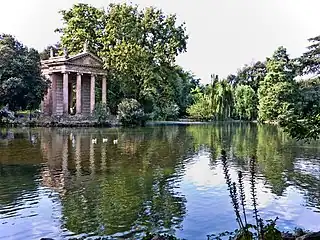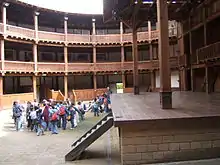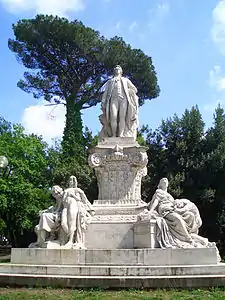| Villa Borghese | |
|---|---|
 Siena Square, inside the Villa Borghese gardens | |
Click on the map for a fullscreen view | |
| Coordinates | 41°54′51″N 12°29′32″E / 41.91417°N 12.49222°E |
Villa Borghese is a landscape garden in Rome, containing a number of buildings, museums (see Galleria Borghese) and attractions. It is the third-largest public park in Rome (80 hectares or 197.7 acres), after the ones of the Villa Doria Pamphili and Villa Ada. The gardens were developed for the Villa Borghese Pinciana ("Borghese villa on the Pincian Hill"), built by the architect Flaminio Ponzio, developing sketches by Scipione Borghese, who used it as a villa suburbana, or party villa, at the edge of Rome, and to house his art collection. The gardens as they are now were remade in the late 19th century.
History
In 1605, Cardinal Scipione Borghese, nephew of Pope Paul V and patron of Bernini, began turning this former vineyard into the most extensive gardens built in Rome since Antiquity. The vineyard's site is identified with the gardens of Lucullus, the most famous in the late Roman republic. Domenico Savino da Montepulciano was responsible for the layout of the gardens.[1]
.jpg.webp)
The Borghese Balustrade was crafted by G di Gincome and P. Massoni in 1618 for the south forecourt of the Casino Nobile. At the center opening there were two stone statues on top and fountains with shell-shaped basins below. The statues were a later addition from 1715 by Claude-Augustin Cayot. In 1882, President Chester A. Arthur appointed William Waldorf Astor Minister to Italy, a post he held until 1885. While living in Rome, Astor developed a lifelong passion for art and sculpture. In 1896, he purchased the balustrade and had it installed at his English estate Cliveden. It is a Grade II Listed Building.[2] In 2004, a colony of small Mediterranean land snails of the species Papillifera bidens was discovered living on the Borghese Balustrade. Presumably, this species, new to the English fauna, was accidentally imported along with the balustrade in the late 19th century and managed to survive the intervening winters to the present day.[3]

In the 18th century, Marcantonio Borghese, 5th Prince of Sulmona transformed the villa's gardens from a formal garden architecture into an English landscape garden. Architect Antonio Asprucci and his son Mario worked on landscaping the villa's gardens, from 1782 for over twenty years. They placed statues around the park and started the construction of the Garden of the Lake and Piazza di Siena. They built the Temple of Aesculapius in the ionic style in the center of the lake between 1785 and 1792.[4]
The Sea Horse Fountain was executed by Vincenzo Pacetti in 1791, based on a design by Christopher Unterberger. The Fountain of Venus was probably designed by Giovanni Vasanzio.
Marcantonio's sons, Camillo and Francesco Borghese expanded the park further. The Villa Borghese gardens were long informally open, but was bought by the commune of Rome and given to the public in 1903.[1] Since 1904 monuments depicting famous foreign personalities and writers such as Victor Hugo, have been placed along the avenues of the villa. The statue of Goethe was a gift to the city of Rome from Wilhelm II, German Emperor.[5]
The large landscape park in the English taste contains several villas. The Spanish Steps lead up to this park, and there is another entrance at the Porte del Popolo by Piazza del Popolo. The Pincio (the Pincian Hill of ancient Rome), in the south part of the park, offers one of the greatest views over Rome.
Camillo Borghese threw grandiose shows and popular festivals, such as a ride in an air balloon from the Piazza di Siena.[5] The first horse show was held at the Piazza di Siena in 1922. The Piazza di Siena hosted the equestrian dressage, individual jumping, and the jumping part of the eventing competition for the 1960 Summer Olympics.
Villas in the gardens

- Today the Galleria Borghese is housed in the Villa Borghese itself. The garden Casino Borghese, built on a rise above the Villa by the architect Giovanni Vasanzio, was set up by Camillo Borghese to contain sculptures by Bernini from the Borghese collection, including his David and his Daphne, and paintings by Titian, Raphael and Caravaggio
- The Villa Giulia adjoining the Villa Borghese gardens was built in 1551 - 1555 as a summer residence for Pope Julius III; now it contains the Etruscan Museum (Museo Etrusco).
- The Villa Medici houses the French Academy in Rome, and the Fortezzuola a Gothic garden structure that houses a collection memorializing the academic modern sculptor Pietro Canonica. In the 1650s, Diego Velázquez painted several depictions of this Villa's garden casino festively illuminated at night. Before electricity, such torchlit illuminations carried an excitement hard to conceive today.
- Other villas scattered through the Villa Borghese gardens are remains of a world exposition in Rome in 1911.
- The Galleria Nazionale d'Arte Moderna located in its grounds has a collection of 19th- and 20th-century paintings emphasizing Italian artists.
- Architecturally the most notable of the 1911 exposition pavilions is the English pavilion designed by Sir Edwin Lutyens (who later designed New Delhi), now housing the British School at Rome.
Other points of interest
.jpg.webp)
- The garden contains a replica of the Shakespeare's Globe Theatre built in 2003.
- Beside the 1911 Exposition's villas, there is the Exposition's Zoo, recently redesigned, with minimal caging, as the Bioparco, and the Zoological Museum (Museo di Zoologia). Nearby is the Casina di Raffaello playroom, which has crafts and reading rooms, and a space where children can dress up in royal outfits.[6]
- In 1873 a hydrochronometer on the 1867 design of Gian Battista Embriaco, O.P.[7] inventor and professor of the Roman College of St. Thomas was built in the gardens in emulation of the one at the College of St. Thomas. Another version stands in the gardens of the Pincian Hill. Embriaco had presented two prototypes of his invention at the Paris Universal Exposition in 1867 where it won prizes and great acclaim.[8]
In popular culture
- The Villa's gardens feature in one of Ottorino Respighi's tone poem Pines of Rome
- The gardens are the setting of chapters 8-11 of Nathaniel Hawthorne's novel The Marble Faun
- The Villa is referenced by Phil Collins in his 1996 song, Lorenzo.
- The gardens are featured in the "Rome Avanti" course in the video games Mario Kart Tour and Mario Kart 8 Deluxe.
- The Villa is mentioned in Fyodor Dostoevsky’s 1864 novel Notes from Underground.
Gallery
.jpg.webp) Alpini monument
Alpini monument Galleria Nazionale d'Arte Moderna
Galleria Nazionale d'Arte Moderna The Silvano Toti Globe Theatre
The Silvano Toti Globe Theatre monument to Goethe
monument to Goethe
See also
Notes
- 1 2 "Villa Borghese Park", Turismo Roma, Major Events, Sport, Tourism and Fashion Department
- ↑ "Villa Borghese Balustrade, Cliveden Estate", National Trust
- ↑ Sharpe, Janet Rideout (March 2005). "Papillifera papillaris (Gastropoda:Clausiliidae): a new record for Britain" (PDF). The Archeo+Malacology Group Newsletter, (7). pp. 6–7. Archived from the original (PDF) on 29 June 2011. Retrieved 1 August 2014.
- ↑ Moorby, Nicola (February 2009). "The Temple of Aesculapius in the Grounds of Villa Borghese, Rome, with the Greek Inscription from its Façade". Tate.
- 1 2 "Villa Borghese", Archeoroma
- ↑ "Villa Borghese", Condé Nast Traveler
- ↑ "Archived copy". Archived from the original on December 16, 2013. Retrieved March 20, 2013.
{{cite web}}: CS1 maint: archived copy as title (link) Accessed 20 March 2013: "È infatti del 1867 l'invenzione dell'idrocronometro, dovuta al padre domenicano Giovanni Battista Embriaco, che attese ai suoi studi di meccanica applicata all'orologeria nella solitudine del convento della Minerva." - ↑ https://www.comune.roma.it/PCR/resources/cms/documents/storia-idrocronometro.pdf Accessed 20 March 2013; "Storia del Progetto"
External links
- 1960 Summer Olympics official report. Volume 1. p. 81.
- 1960 Summer Olympics official report. Volume 2, Part 2. p. 899.
- Galleria Borghese
 See Borghese Gardens travel guide from Wikivoyage
See Borghese Gardens travel guide from Wikivoyage Media related to Villa Borghese at Wikimedia Commons
Media related to Villa Borghese at Wikimedia Commons
| Preceded by Villa Ada |
Landmarks of Rome Villa Borghese gardens |
Succeeded by Villa Doria Pamphili |
